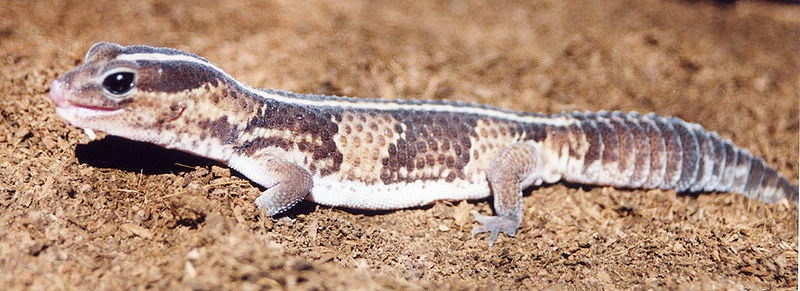How do you breed African fat-tailed geckos?
Q. I have two African fat-tailed geckos (Hemitheconyx caudicinctus) named Dos Cabesas and White Lightning. One is a heterozygous for albino female, the other is a normal male. I plan on breeding my African fat-tailed geckos because they are both about 7 inches long, though I don’t know their actual ages. The female has already laid eggs that didn’t hatch. I give them a calcium supplement with their crickets and have already separated them before breeding. Any suggestions? You probably get this question all the time, but I’d appreciate the information.
Brody Berry
West Bloomfield, Mich.
A. This is a common question, but maybe it’s time to go over the information again for newer readers. You’ve obviously kept these African fat-tailed geckos for a while and know one is a female — eggs don’t lie. Now you have to be sure the other one is a male. Male African fat-tailed geckos have a broader, heavier head than females, and the base of their tail is swollen to house the hemipenes. Males also have obvious pores under the base of the hind legs, which are absent in females. Sexing the African fat-tailed gecko usually is not a problem.

Hexasoft/Wikipedia
African fat-tailed gecko.
A calcium supplement is a good idea, especially for the female African fat-tailed gecko. She uses the extra calcium for eggshells. You might try varying the diet a bit; feeding only crickets is not a complete diet. Try a baby mouse once a month and different insects, such as waxworms and mealworms, once a week.
Opinions vary on whether separating the sexes is best for mating or not, but it really doesn’t hurt. There is no harm in continuing it. Although captive-bred African fat-tailed geckos may breed anytime of the year, it is best to try for an autumn mating. African fat-tailed geckos may need a small drop in temperatures to spur successful mating. In November, the room temperature at night should be several degrees lower than just a few months earlier. Make sure African fat-tailed geckos have a cool end to their breeding cage, one where the temperature in the hide box drops to about 75 degrees Fahrenheit at night. Maintain the usual 90-degree day temperature, and make sure the cage is not damp.
Mating is likely to take place at night and go unnoticed, though males often chase females. Keep an eye on your female’s belly once you put the African fat-tailed geckos back together. If mating was successful, you should notice developing eggs through her belly skin about three to four weeks later, and laying will take place shortly. Give the female an egg-laying container filled with moist vermiculite and a hole cut in the side for an entrance. Watch for the eggs. As usual for geckos, there are two eggs in a clutch.
Incubation takes 55 to 80 days or so, and the sex of hatchling African fat-tailed geckos depends on their incubation temperature. A temperature of 86 to 88 degrees produces mostly or all males, whereas one a few degrees higher or lower than this produces females. Thus an incubation temperature of about 84 to 86 degrees should give you a mix of both sexes. The babies are active and feed immediately, and they grow quickly, becoming ready to mate when 12 to 18 months old.
If you have problems with fertility, remember that one male African fat-tailed gecko can serve two or three females, so try expanding your colony. If the eggs still are infertile, then your male is the problem. He will have to be replaced for breeding, though he still will make a great pet.


